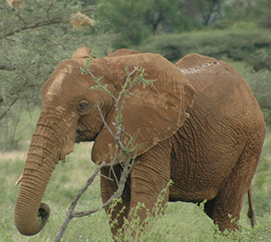
Planets
The dominant Planets family is now reduced to a few young females. Luna split from the last of the Planets and now spends a great deal of time with Alpin, the matriarch of the Flowers.
 © Jane Wynyard
© Jane Wynyard
The surge in poaching over the last several years and the drought of 2009 have left many elephant orphans and disrupted families in Samburu. Some orphans choose to remain with what is left of their disrupted groups, others leave their natal group to attach to unrelated individuals. Still others become drifters, showing some social preference but not fully committing to any one group.
Shifra Goldenberg, a PhD Candidate at Colorado State University working under George Wittemyer, chair of STE’s scientific board, is studying these strategies more deeply. It has become very clear that the social intelligence of these animals affords them resilience in the face of intense periods of disruption. By following their social and reproductive lives, we hope to understand how elephants cope with high rates of mortality and what this will ultimately mean for the population.

The dominant Planets family is now reduced to a few young females. Luna split from the last of the Planets and now spends a great deal of time with Alpin, the matriarch of the Flowers.

The leaders of the First Ladies, Mary Todd Lincoln and Maya Churchill, went missing during a spike in poaching during November 2011. Maya’s death left Rosalynn, her 18-year old daughter, as the family’s oldest surviving female.

The tragic death of the last remaining mature female of the Swahili Ladies left 12-year old Habiba to lead what is left of her family: her cousins Layla, Hadithi and a young male calf named Swahili Boy. A tuskless old matriarch from the Spices family named Cinnamon has taken them under her wing.

The American Indians rarely venture far outside the reserves. After drought and poaching killed four family elders, Amayeta left the remaining young females to be with Alpin from the Flowers.